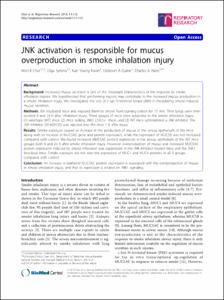KUMEL Repository
1. Journal Papers (연구논문)
1. School of Medicine (의과대학)
Dept. of Internal Medicine (내과학)
JNK activation is responsible for mucus overproduction in smoke inhalation injury
- Keimyung Author(s)
- Choi, Won Il; Kwon, Kun Young
- Journal Title
- Respiratory Research
- Issued Date
- 2010
- Volume
- 11
- Issue
- 1
- Abstract
- Background: Increased mucus secretion is one of the important characteristics of the response to smoke inhalation injuries. We hypothesized that gel-forming mucins may contribute to the increased mucus production in a smoke inhalation injury. We investigated the role of c-Jun N-terminal kinase (JNK) in modulating smoke-induced mucus secretion.
Methods: We intubated mice and exposed them to smoke from burning cotton for 15 min. Their lungs were then isolated 4 and 24 h after inhalation injury. Three groups of mice were subjected to the smoke inhalation injury: (1) wild-type (WT) mice, (2) mice lacking JNK1 (JNK1-/- mice), and (3) WT mice administered a JNK inhibitor. The JNK inhibitor (SP-600125) was injected into the mice 1 h after injury.
Results: Smoke exposure caused an increase in the production of mucus in the airway epithelium of the mice along with an increase in MUC5AC gene and protein expression, while the expression of MUC5B was not increased compared with control. We found increased MUC5AC protein expression in the airway epithelium of the WT mice groups both 4 and 24 h after smoke inhalation injury. However, overproduction of mucus and increased MUC5AC protein expression induced by smoke inhalation was suppressed in the JNK inhibitor-treated mice and the JNK1 knockout mice. Smoke exposure did not alter the expression of MUC1 and MUC4 proteins in all 3 groups compared with control.
Conclusion: An increase in epithelial MUC5AC protein expression is associated with the overproduction of mucus in smoke inhalation injury, and that its expression is related on JNK1 signaling.
- Publisher
- School of Medicine
- Citation
- Won-Il Choi et al. (2010). JNK activation is responsible for mucus overproduction in smoke inhalation injury. Respiratory Research, 11(1), 172–178. doi: 10.1186/1465-9921-11-172
- Type
- Article
- ISSN
- 1465-993X
- Appears in Collections:
- 1. School of Medicine (의과대학) > Dept. of Internal Medicine (내과학)
1. School of Medicine (의과대학) > Dept. of Pathology (병리학)
- 파일 목록
-
-
Download
 oak-aaa-4251.pdf
기타 데이터 / 1.33 MB / Adobe PDF
oak-aaa-4251.pdf
기타 데이터 / 1.33 MB / Adobe PDF
-
Items in Repository are protected by copyright, with all rights reserved, unless otherwise indicated.